Solar water preheating saves you money by greatly reducing your energy bills. These systems use sunlight to warm water before it enters your main water heater, cutting your reliance on expensive electricity or gas. You'll see immediate savings on your utility costs, with potential reductions of 50-80% in water heating expenses. Over time, these savings can offset the initial investment. Plus, you'll increase your home's value and reduce your carbon footprint. Government incentives and rebates can make installation even more affordable. With easy maintenance and a lifespan of 20-30 years, the benefits of solar water preheating continue to add up.
Understanding Solar Water Preheating Systems

While many homeowners are familiar with solar panels for electricity generation, solar water preheating systems offer a different way to harness the sun's energy.
These systems use solar collectors to absorb sunlight and transfer the heat to water stored in a tank. You'll typically find two main types: flat-plate collectors and evacuated tube collectors.
Flat-plate collectors consist of a dark, flat surface that absorbs heat, covered by a glass or plastic layer to trap warmth. They're cost-effective and work well in warm climates.
Evacuated tube collectors use glass tubes with a vacuum inside, making them more efficient in colder regions.
Your solar water preheater works alongside your existing water heater. It preheats the water before it enters your conventional system, reducing the energy needed to reach the desired temperature.
This setup can greatly cut your water heating costs, which often account for a large portion of your energy bill.
The system's efficiency depends on factors like your location, climate, and household water usage.
In ideal conditions, you can expect to save 50-80% on your water heating expenses.
Cost Savings on Energy Bills
You'll see a significant reduction in your hot water expenses when you install a solar water preheating system.
Your electricity consumption will drop as the sun's energy takes on more of the burden of heating your water.
Over time, these savings add up, providing substantial long-term utility cost reductions that offset the initial investment.
Reduced Hot Water Expenses
Solar water preheating systems can considerably reduce your hot water expenses. By harnessing the sun's energy to preheat your water, you'll rely less on conventional heating methods, which often use expensive electricity or gas. This means you'll see a significant drop in your energy consumption for water heating, which typically accounts for 20-30% of a household's energy use.
You'll notice immediate savings on your utility bills as soon as you install a solar water preheater. Depending on your location, system size, and hot water usage, you could cut your water heating costs by 50-80%. In sunny climates, these savings can be even higher. Over time, these reduced expenses add up to substantial financial benefits.
Moreover, you'll be less affected by fluctuating energy prices. As utility rates continue to rise, your savings will increase proportionally. This provides a hedge against future energy cost increases.
Additionally, some regions offer rebates or tax incentives for installing solar water heaters, further enhancing your savings. By reducing your hot water expenses, you're not just saving money; you're also investing in a more sustainable and cost-effective future.
Lower Electricity Consumption
Beyond the direct savings on water heating, solar preheating systems greatly reduce your overall electricity consumption. You'll notice a significant drop in your electric bills as your reliance on grid power diminishes. This reduction stems from the decreased need for your conventional water heater to work as hard, as the solar system does much of the heavy lifting.
The extent of your electricity savings depends on various factors, including your household's hot water usage, climate, and system efficiency. On average, you can expect to cut your water heating electricity costs by 50-80%. This translates to substantial annual savings, especially in areas with high electricity rates.
| System Size | Avg. Annual Savings | Payback Period |
|---|---|---|
| Small | $200 – $300 | 5-7 years |
| Medium | $300 – $500 | 4-6 years |
| Large | $500 – $800 | 3-5 years |
Long-Term Utility Savings
Over the course of your solar water preheating system's lifespan, you'll accumulate substantial utility savings. These systems typically last 20 to 30 years, providing long-term financial benefits. As energy prices continue to rise, your savings will increase proportionally, protecting you from future rate hikes.
You'll notice immediate reductions in your monthly utility bills, often ranging from 50% to 80% for water heating costs. This translates to hundreds of dollars saved annually, with the potential for even greater savings in areas with high electricity rates or sunny climates.
Over time, these monthly savings add up considerably, potentially reaching tens of thousands of dollars over the system's lifetime.
Additionally, many regions offer incentives, rebates, or tax credits for installing solar water preheaters, further enhancing your long-term savings. These financial benefits, combined with reduced reliance on the grid, make solar water preheating a wise investment for homeowners looking to cut costs and increase energy independence.
Reduced Reliance on Fossil Fuels
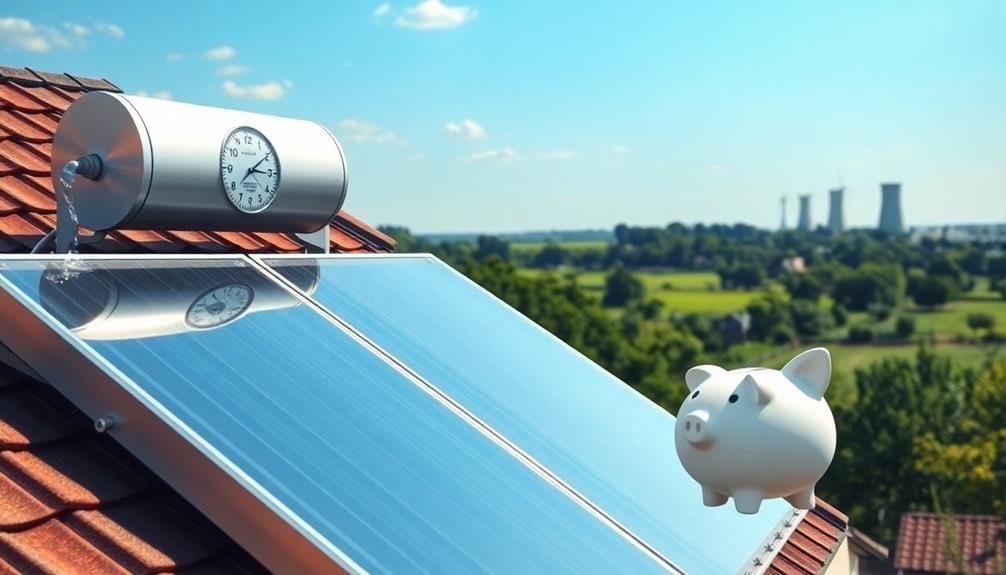
Sustainability takes center stage when you install a solar water preheating system. By harnessing the sun's energy to heat your water, you're greatly reducing your dependence on fossil fuels. This shift not only benefits your wallet but also contributes to a cleaner environment.
Traditional water heating methods often rely on natural gas, oil, or electricity generated from non-renewable sources. In contrast, solar preheating taps into an abundant, clean energy source. You'll notice a substantial decrease in your consumption of these finite resources, which helps conserve them for future generations.
As you reduce your fossil fuel usage, you're also lowering your carbon footprint. Solar water preheating systems emit no greenhouse gases during operation, unlike their conventional counterparts. This reduction in emissions helps combat climate change and air pollution, making your home more eco-friendly.
Moreover, by decreasing your reliance on fossil fuels, you're less vulnerable to price fluctuations in the energy market. You'll have more control over your energy costs and be better prepared for potential future increases in fossil fuel prices.
This increased energy independence provides long-term stability and peace of mind.
Increased Home Value
Installing a solar water preheating system can greatly boost your home's value.
You'll find that this eco-friendly upgrade is attractive to potential buyers, setting your property apart in a competitive market.
Beyond immediate appeal, the long-term investment returns from reduced energy costs make your home a smart financial choice for future owners.
Attractive to Potential Buyers
For homebuyers seeking eco-friendly features, a solar water preheating system can be a major selling point. It demonstrates your commitment to sustainability and energy efficiency, which can attract environmentally conscious buyers.
When you're ready to sell your home, this feature can set your property apart from others on the market. Many potential buyers are looking for ways to reduce their carbon footprint and lower their energy bills. A solar water preheating system addresses both of these concerns.
It's a visible, tangible investment in green technology that can appeal to a growing segment of the housing market. You'll find that real estate agents often highlight such energy-efficient upgrades in their listings. They know that these features can draw more interest and potentially lead to faster sales.
Buyers may see the system as a value-added feature that saves them the trouble and expense of installation after purchase. Moreover, as energy costs continue to rise, homes with solar water preheating systems become increasingly attractive.
Buyers recognize the long-term savings potential and may be willing to pay a premium for a home that's already equipped with this technology.
Long-Term Investment Returns
While the immediate benefits of a solar water preheating system are apparent in reduced energy bills, the long-term investment returns can be even more notable. As you consider installing this eco-friendly technology, it's essential to understand its impact on your home's value.
Studies have shown that homes with solar water heating systems can see an increase in value of up to 3-4%. This boost is due to the system's energy efficiency and the growing demand for sustainable features among homebuyers. You're not just saving money on utilities; you're also investing in your property's future marketability.
The longevity of solar water heaters, typically lasting 20-30 years, means you'll enjoy these benefits for decades. Over time, the cumulative energy savings can far exceed the initial installation costs. As energy prices continue to rise, your investment becomes even more valuable.
Additionally, government incentives and tax credits can notably offset the upfront costs, making the long-term returns even more attractive. By choosing a solar water preheating system, you're making a smart financial decision that pays dividends in both immediate savings and future home value appreciation.
Government Incentives and Rebates
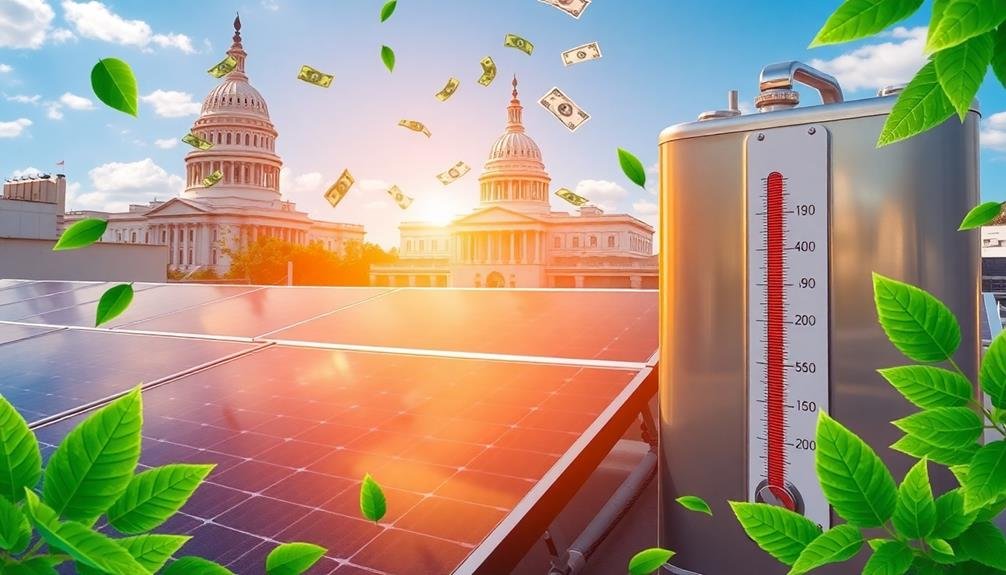
Many governments offer incentives and rebates to encourage the adoption of solar water preheating systems. These financial benefits can considerably reduce your upfront costs and accelerate your return on investment. Federal tax credits in the U.S. often cover up to 30% of the system's cost, while state and local governments may provide additional rebates or low-interest loans.
You'll need to research the specific incentives available in your area, as they vary by location and can change over time. Some utility companies also offer rebates or performance-based incentives for solar water heating installations.
To maximize your savings, combine these offers with manufacturer rebates and discounts. When applying for incentives, you'll typically need to provide proof of purchase and installation by a certified professional.
Keep detailed records of your expenses and energy savings to support your claims. It's crucial to recognize that some incentives have caps or expiration dates, so act quickly to take full advantage of them.
Easy Installation and Maintenance
Installing a solar water preheating system is surprisingly straightforward, especially when compared to other home improvement projects.
You'll find that most systems can be set up in just a day or two, with minimal disruption to your daily routine. The process typically involves mounting solar collectors on your roof, connecting them to your existing water heater, and installing a small pump and controller.
Once installed, solar water preheaters require very little maintenance.
You'll need to perform occasional visual inspections to verify the collectors are clean and free from debris. Every few years, you might need to replace the heat-transfer fluid in the system, but this is a simple task that you can often do yourself. The longevity of these systems is impressive, with many lasting 20 years or more with proper care.
You'll also appreciate the user-friendly nature of solar water preheaters.
Most systems come with automatic controls that regulate water temperature and flow, so you don't have to worry about constant adjustments. If you ever encounter issues, troubleshooting is generally straightforward, and many problems can be resolved without professional help, saving you money on service calls.
Environmental Benefits of Solar Preheating
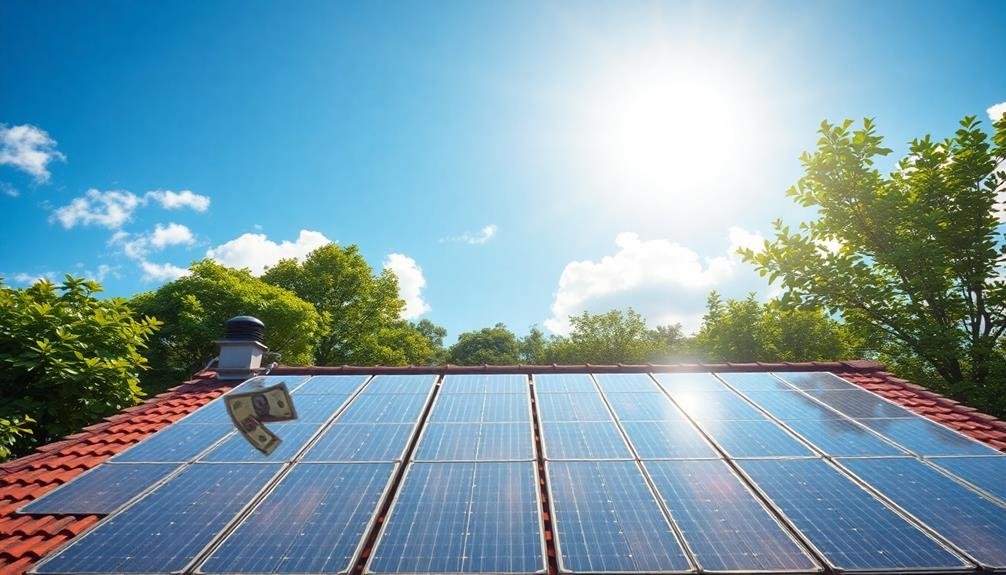
Beyond cost savings, solar water preheating offers considerable environmental benefits. By harnessing the sun's energy to heat your water, you're reducing your reliance on fossil fuels and decreasing your carbon footprint. This eco-friendly approach helps combat climate change and preserves natural resources for future generations.
Solar preheating systems considerably reduce greenhouse gas emissions compared to traditional water heating methods. You'll be contributing to cleaner air and a healthier planet by choosing this renewable energy solution. Additionally, solar preheating reduces the strain on the electrical grid, especially during peak demand periods.
Here's a quick comparison of solar preheating's environmental impact:
| Aspect | Solar Preheating | Conventional Heating |
|---|---|---|
| CO2 Emissions | Low | High |
| Fossil Fuel Use | Minimal | Considerable |
| Renewable Energy | Yes | No |
| Grid Dependence | Reduced | High |
Frequently Asked Questions
How Long Does a Solar Water Preheating System Typically Last?
You'll be pleased to know that solar water preheating systems typically last 20 to 30 years with proper maintenance. They're durable and reliable, offering you long-term benefits. Regular check-ups can help extend their lifespan even further.
Can Solar Preheating Be Combined With Traditional Water Heating Methods?
Yes, you can easily combine solar preheating with traditional water heating methods. You'll use solar energy to preheat water, reducing the workload on your conventional system. This hybrid approach maximizes efficiency and saves you money on energy bills.
What Happens to the System During Cloudy or Rainy Days?
During cloudy or rainy days, your solar preheating system won't be as effective. You'll rely more on your backup heating method, like a traditional water heater. Don't worry though, the system will still contribute some heat, just not as much.
Are There Any Safety Concerns Associated With Solar Water Preheating?
You should be aware of a few safety concerns with solar water preheating. There's a risk of scalding from hot water, potential for system leaks, and the danger of falls during installation or maintenance on your roof.
How Does Solar Preheating Affect Water Pressure in the Home?
Solar preheating doesn't typically affect your home's water pressure. You'll still have the same flow rate from your taps. The system simply warms the water before it enters your regular water heater, maintaining normal pressure throughout.
In Summary
You've seen how solar water preheating can benefit your wallet and the planet. It'll slash your energy bills, boost your home's value, and reduce your carbon footprint. With easy installation, low maintenance, and potential government incentives, it's a smart investment. By harnessing the sun's power, you're not just saving money; you're contributing to a cleaner, more sustainable future. Consider making the switch to solar water preheating today.

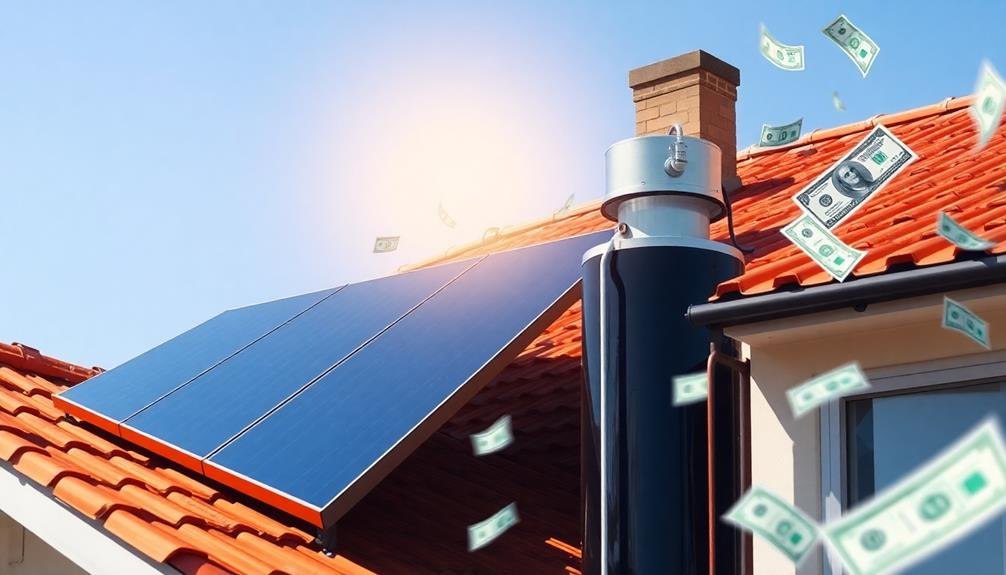
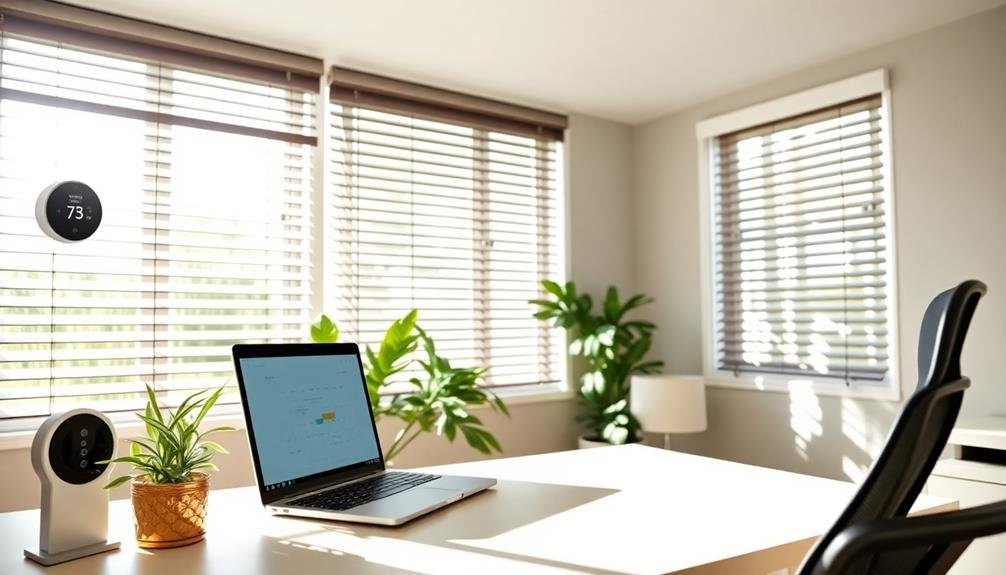
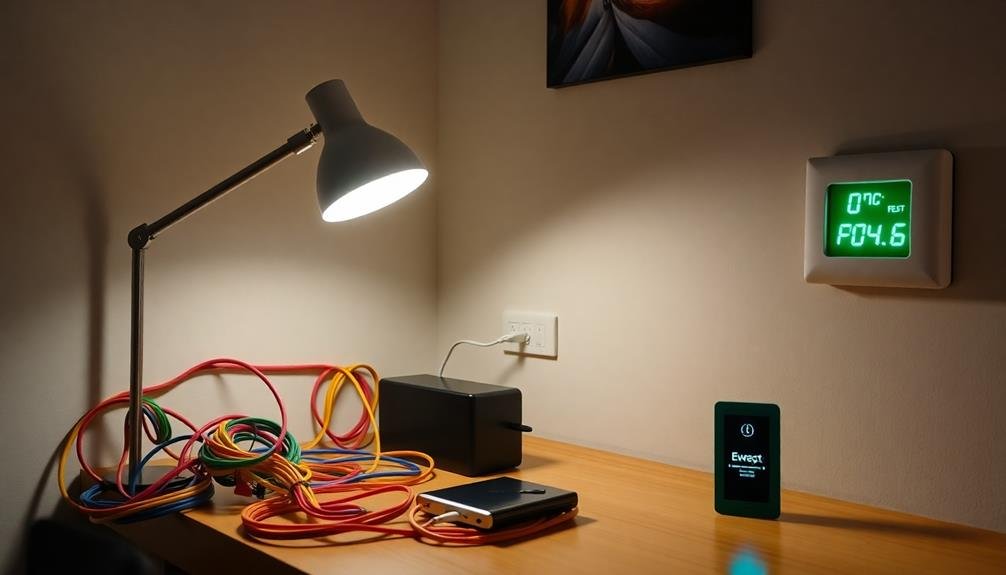
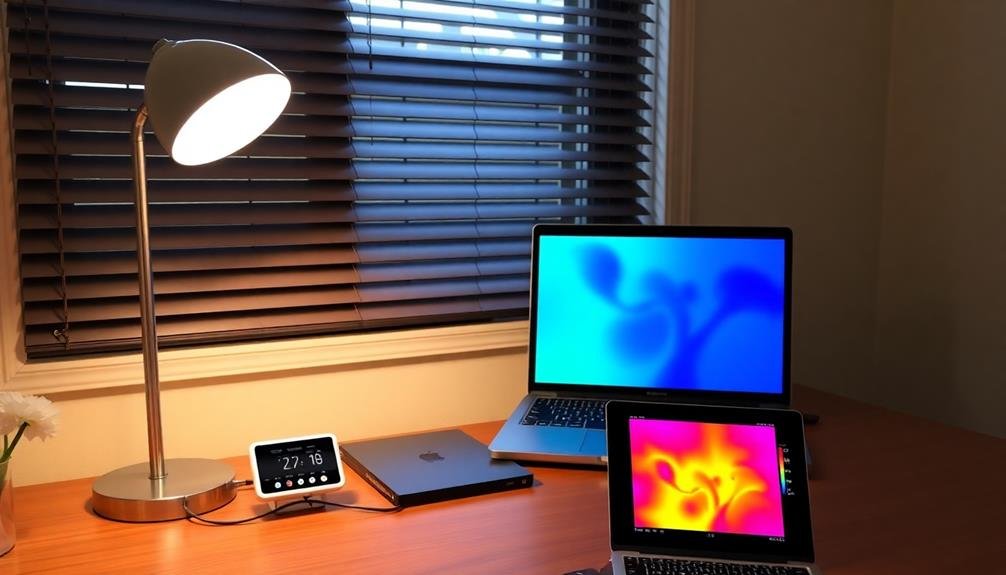
Leave a Reply